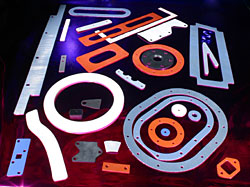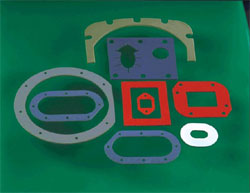 Cut parts Cut parts
The materials used for cutting joints are selected from all of the formulae available to S.E.E. Their choice depends on the final application.
Parts are cut from plates:
- 1000 X 1000 mm
-
500 X 500 mm
-
250 X 250 mm
- or 30 metres by 500 mm strips.
The products can be reinforced by one or several textiles made of polyester, glass, ceramic, etc.
Silicone or neoprene rubber composites, with a Teflon® face 0.5 to1 mm thick, are used for anti-friction, high chemical resistance and non-stick applications.
Teflon® strips may be cut in different widths in thicknesses of 0.3, 0.6 or 1 mm with, if necessary, an adhesive face (silicone or acrylic adhesive).
The appearance of the cut parts may be either smooth or fabric grain.
Processes
Standard cut using combination tools, from several mm up to a diameter of 500 mm.
For other shapes, the creation of light and inexpensive tooling is necessary.
 Needle cutting Needle cutting
Joints cut using standard procedures always have a more or less pronounced meniscus, which depends on the thickness and the hardness of the strip.
The needle cutting process eliminates this disadvantage; the width of the strip may be less than the thickness of the joint.
Cutting and welding
In the case of large sized joints, sectors are cut, which are then hot welded together by adding crude rubber.
Rectified cut extruded joints
In order to obtain mass production quantities of washers, tubes are extruded. They are then placed on control rods and adjusted to the requested tolerance, then cut on special machines.
NB: Please consult us for the tolerances of the different processes.
|

